Real Leather vs “Genuine Leather”
“Genuine Leather” is like saying a hot dog is meat, always be sure to purchase from artisans who use whole grain leather.
When it comes to leather goods, discerning between "whole grain leather" and "genuine leather" can significantly impact the quality and longevity of your purchase. Often misconstrued by flashy marketing terms, consumers may find "genuine leather" appealing both for its affordability and the perception of quality. However, understanding what these terms truly mean can save you from potentially regrettable decisions—much like comparing it to grasping the difference between the vague notion that a "hotdog is meat" especially when compared to a porterhouse, which is a high-quality cut of steak.
Whole Grain Leather: The Pinnacle of Craftsmanship
Whole grain leather, often referred to as full-grain leather, is the highest quality leather available. Derived from the top layer of the hide, it showcases all the natural grain and imperfections, making every piece unique. The tight grain pattern of this leather provides exceptional strength and durability. Contrary to other types, it has not been sanded or buffed to remove imperfections, maintaining the hide’s authentic characteristics.
One of the standout qualities of whole grain leather is its ability to develop a rich patina over time. This naturally occurring gloss results from regular use and age, enhancing its appearance and adding personalized charm rather than diminishing it. Furthermore, whole grain leather is breathable and less prone to moisture damage, making it an ideal choice for goods subjected to daily wear.
Genuine Leather: A Misleading Middle Ground
On the flip side, "genuine leather" is an industry term that refers to a middle grade of leather. It ranks below whole grain and top-grain leather, though it sounds promising. Genuine leather is made from the layers remaining after the top is split from the hide. These layers are often sanded down and coated with artificial textures to give a uniform appearance.
Genuine leather lacks the natural breathability of whole grain, which can lead to quicker degradation and a propensity to peel or crack over time. It doesn’t develop the same patina, as its natural top layer has been removed and treated. While often cheaper, the cost savings can be negated by the need for frequent replacements compared to the longevity of whole grain products.
In summary, choosing between whole grain and genuine leather hinges on understanding quality, longevity, and authenticity. Whole grain promises a classic, enduring product that ages beautifully, much like a choice top-grade steak. Genuine leather, though practical and affordable, might result in compromise both in looks and durability. Choose wisely, much like opting for a meticulously selected, quality meat over an undefined cut.


